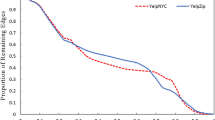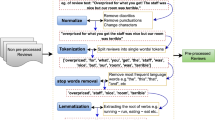Abstract
An approach based on a combination of semantic and non-semantic features of reviews is recognized as the most effective method for detecting fake reviews. However, existing deep learning-based fake review detection models have two main limitations. The first one is the extraction of word embedding, they only consider acquiring semantic features of text, but ignore that a good word embedding should ensure uniformity and alignment. Secondly, the non-semantic features are not effectively utilized. To solve these problems, this paper proposes a deep learning fake review detection model MFBH (Multi-feature Fusion using BERT-whitening and Heterogeneous graph attention network). It uses the BERT-whitening model in the text feature extraction part, i.e., the vectors extracted by BERT are linearly transformed into isotropic vectors conforming to the standard Gaussian distribution. In addition eight non-semantic features are extracted as entity links of meta-paths.Finally, the obtained text features are used as the node features of the graph and the adjacency matrix composed of meta-paths as the structural features of the graph, and the features are fused through a heterogeneous graph attention network. Experiments were conducted on the publicly available dataset of Yelp website, and the accuracy reached 93.81% on the restaurant dataset and 90.25% on the hotel dataset, which proved the effectiveness and generalization of the MFBH model.
Access this chapter
Tax calculation will be finalised at checkout
Purchases are for personal use only
Similar content being viewed by others
References
Samha, A.K., Li, Y., Zhang, J.: Aspect-based opinion extraction from customer reviews. ar**v preprint ar**v:1404.1982 (2014)
**dal, N., Liu, B.: Opinion spam and analysis. Proceedings of the 2008 international conference on web search and data mining, 219–230 (2008)
Ott, M., Choi, Y., Cardie, C., et al.: Finding deceptive opinion spam by any stretch of the imagination. ar**v preprint ar**v:1107.4557 (2011)
Mukherjee, A., Venkataraman, V., Liu, B., et al.: What yelp fake review filter might be doing? Proceedings of the international AAAI conference on web and social media 7(1), 409–418 (2013)
Devlin, J., Chang, M.W., Lee, K., et al.: Bert: Pre-training of deep bidirectional transformers for language understanding. ar**v preprint ar**v:1810.04805 (2018)
Wang, T., Isola, P.: Understanding contrastive representation learning through alignment and uniformity on the hypersphere. International Conference on Machine Learning. PMLR, pp. 9929–9939 (2020)
Li, B., Zhou, H., He, J., et al.: On the sentence embeddings from pre-trained language models. ar**v preprint ar**v:2011.05864 (2020)
Rayana, S., Akoglu, L.: Collective opinion spam detection: Bridging review networks and metadata. Proceedings of the 21th acm sigkdd international conference on knowledge discovery and data mining, pp. 985–994 (2015)
Ali Alhosseini, S., Bin Tareaf, R., Najafi, P., et al.: Detect me if you can: Spam bot detection using inductive representation learning. Companion Proceedings of The 2019 World Wide Web Conference, pp. 148–153 (2019)
Li, A., Qin, Z., Liu, R., et al.: Spam review detection with graph convolutional networks. Proceedings of the 28th ACM International Conference on Information and Knowledge Management, pp. 2703–2711 (2019)
**dal, N., Liu, B.: Analyzing and detecting review spam. Seventh IEEE international conference on data mining (ICDM 2007). IEEE, pp. 547–552 (2007)
Li, L., Qin, B., Ren, W., et al.: Document representation and feature combination for deceptive spam review detection. Neurocomputing 254, 33–41 (2017)
Huang, J., Tang, D., Zhong, W., et al.: Whiteningbert: An easy unsupervised sentence embedding approach. ar**v preprint ar**v:2104.01767 (2021)
Ott, M., Cardie, C., Hancock, J.T.: Negative deceptive opinion spam. Proceedings of the 2013 conference of the north american chapter of the association for computational linguistics: human language technologies, pp. 497–501 (2013)
Barushka, A., Hajek, P.: Review spam detection using word embeddings and deep neural networks. Artificial Intelligence Applications and Innovations: 15th IFIP WG 12.5 International Conference, AIAI 2019, Hersonissos, Crete, Greece, May 24–26, 2019, Proceedings 15. Springer International Publishing, pp. 340–350 (2019)
Ren, Y., Zhang, Y.: Deceptive opinion spam detection using neural network. Proceedings of COLING 2016, the 26th International Conference on Computational Linguistics: Technical Papers, pp. 140–150 (2016)
Zeng, Z.Y., Lin, J.J., Chen, M.S., et al.: A review structure based ensemble model for deceptive review spam. Information 10(7), 243 (2019)
Krishnamurthy, G., Majumder, N., Poria, S., et al.: A deep learning approach for multimodal deception detection. Computational Linguistics and Intelligent Text Processing: 19th International Conference, CICLing 2018, Hanoi, Vietnam, March 18–24, 2018, Revised Selected Papers, Part I, pp. 87–96. Springer Nature Switzerland, Cham (2023)
Yang, Z., Yang, D., Dyer, C., et al.: Hierarchical attention networks for document classification. Proceedings of the 2016 conference of the North American chapter of the association for computational linguistics: human language technologies, pp. 1480–1489 (2016)
Jiang, C., Zhang, X.: Neural networks merging semantic and non-semantic features for opinion spam detection. Natural Language Processing and Chinese Computing: 8th CCF International Conference, NLPCC 2019, Dunhuang, China, October 9–14, 2019, Proceedings, Part I 8, pp. 583–595. Springer International Publishing (2019)
Su, J., Cao, J., Liu, W., et al.: Whitening sentence representations for better semantics and faster retrieval. ar**v preprint ar**v:2103.15316 (2021)
Ma, J., Zhang, D., Wang, Y., et al.: GraphRAD: a graph-based risky account detection system. Proceedings of ACM SIGKDD conference, p. 9. London, UK (2018)
Zhang, S., Yin, H., Chen, T., et al.: Gcn-based user representation learning for unifying robust recommendation and fraudster detection. Proceedings of the 43rd international ACM SIGIR conference on research and development in information retrieval, pp. 689–698 (2020)
Dou, Y., Liu, Z., Sun, L., et al.: Enhancing graph neural network-based fraud detectors against camouflaged fraudsters. Proceedings of the 29th ACM International Conference on Information & Knowledge Management, pp. 315–324 (2020)
Wang, X., Ji, H., Shi, C., et al.: Heterogeneous graph attention network. The world wide web conference, pp. 2022–2032 (2019)
Min, Z., Yueqin, Z., Yingtong, D.O.U., et al.: Imbalanced Fake Reviews? Detection with Ensemble Hierarchical Graph Attention Network. J. Fronti. Comp. Sci. Technol. 17(2), 428 (2023)
Reimers, N., Gurevych, I.: Sentence-bert: Sentence embeddings using siamese bert-networks. ar**v preprint ar**v:1908.10084 (2019)
Dykstra, R.L.: Establishing the positive definiteness of the sample covariance matrix. Ann. Math. Stat. 41(6), 2153–2154 (1970)
Korfiatis, N., García-Bariocanal, E., Sánchez-Alonso, S.: Evaluating content quality and helpfulness of online product reviews: The interplay of review helpfulness vs. review content. Electr. Comm. Res. Appl. 11(3), 205–217 (2012)
Fei, G., Mukherjee, A., Liu, B., et al.: Exploiting burstiness in reviews for review spammer detection. Proceedings of the international AAAI conference on web and social media, 7(1), 175–184 (2013)
Ren, Z., Shen, Q., Diao, X., et al.: A sentiment-aware deep learning approach for personality detection from text. Inf. Process. Manage. 58(3), 102532 (2021)
Author information
Authors and Affiliations
Corresponding author
Editor information
Editors and Affiliations
Rights and permissions
Copyright information
© 2023 The Author(s), under exclusive license to Springer Nature Switzerland AG
About this paper
Cite this paper
Ren, Z., Zhang, X., Zhang, S., Yang, C. (2023). Fake Review Detection via Heterogeneous Graph Attention Network. In: Iliadis, L., Papaleonidas, A., Angelov, P., Jayne, C. (eds) Artificial Neural Networks and Machine Learning – ICANN 2023. ICANN 2023. Lecture Notes in Computer Science, vol 14257. Springer, Cham. https://doi.org/10.1007/978-3-031-44216-2_30
Download citation
DOI: https://doi.org/10.1007/978-3-031-44216-2_30
Published:
Publisher Name: Springer, Cham
Print ISBN: 978-3-031-44215-5
Online ISBN: 978-3-031-44216-2
eBook Packages: Computer ScienceComputer Science (R0)




